The Truth About Dry Brushing and Whether It Actually Works
Everyone’s talking about dry brushing but does it actually work? Let’s separate facts from hype and see if it’s worth adding to your routine.

The beauty world loves a good trend, and dry brushing has managed to stick around for years. It’s the kind of practice that feels luxurious yet oddly satisfying, running a bristled brush over your skin with the promise of glowing results. Some swear by it for boosting circulation, exfoliating dead skin, and even reducing cellulite. Others roll their eyes, calling it just another overhyped wellness ritual.
But does dry brushing actually do anything, or is it just another social media beauty obsession? If you’ve ever found yourself standing in the body care aisle, staring at a dry brush, wondering if it’s worth adding to your routine, you’re not alone. Before you go all in and start brushing your way to radiant skin, let’s get to the bottom of what dry brushing really does, and whether the benefits live up to the hype.
What Dry Brushing Does and Whether It Works
Dry brushing isn’t just about sweeping a fancy brush over your skin and hoping for miracles. It’s a method rooted in an old-school beauty philosophy that believes exfoliation and circulation go hand in hand. The technique involves using a stiff-bristled brush on dry skin before showering, working in upward motions to slough off dead skin and get the blood flowing. But what exactly happens when you commit to this ritual?
Exfoliation Without the Scrub
One of the biggest reasons people reach for a dry brush is exfoliation. Unlike body scrubs that rely on oils and granules to buff away dead skin, a dry brush does the job without any product. The firm bristles lift away flaky skin, leaving your body feeling smoother and softer almost instantly. Over time, this consistent exfoliation can help prevent ingrown hairs and improve skin texture, making it a solid alternative to traditional scrubs.
Circulation Boost and That Instant Glow
One of the more intriguing claims about dry brushing is its effect on circulation. The process of dragging bristles across the skin stimulates blood flow, creating that post-brush flush. This temporary boost makes the skin appear more vibrant and awake, which is why many people swear by it for that instant glow. While it won’t work miracles overnight, improved circulation can support skin cell turnover, contributing to long-term radiance when done consistently.
Lymphatic Drainage and Detox Claims
Here’s where things get a little murky. Many dry brushing enthusiasts claim that the practice detoxifies the body by stimulating the lymphatic system. The idea is that dry brushing encourages lymphatic drainage, helping the body eliminate toxins more efficiently. While lymphatic drainage is a real process, the body already does this on its own, thanks to the lymph nodes. Dry brushing might support this natural function, but it’s not a magic detox button.
Does It Actually Reduce Cellulite?
If you’ve ever seen dry brushing marketed as a cellulite eraser, take that with a grain of salt. While the stimulation and improved circulation may temporarily make skin look firmer, there’s no scientific proof that dry brushing can permanently reduce cellulite. The effects are surface-level, meaning your skin may look a little smoother right after brushing, but long-term cellulite reduction? That’s a different story.
Science-Backed Benefits and What’s Just Marketing
Dry brushing has been around long enough to collect a laundry list of benefits, but not all of them hold up under scientific scrutiny. Some claims have solid backing, while others sound nice on paper but don’t exactly hold weight when examined closely. So, let’s break it down: what’s actually happening when you dry brush, and what’s just clever marketing?
Exfoliation That Works Without Harsh Ingredients
This one is 100% real. Dry brushing is a physical exfoliator, meaning it removes dead skin cells sitting on the surface. Unlike chemical exfoliators that rely on acids to dissolve buildup, dry brushing simply sloughs away flaky patches manually. If your skin is feeling dull or rough, dry brushing can help reveal a fresher, smoother layer underneath.
Circulation Boost but Not a Full-Body Reset
There’s no denying that dry brushing increases blood flow, which is why your skin may appear pink or flushed after a session. Increased circulation can contribute to healthier-looking skin, but claims that it "revitalizes your entire body" or “supercharges your immune system” are a bit of a stretch.
Lymphatic Drainage Support but Not a Detox Cure
Dry brushing does encourage lymphatic movement, which can help with puffiness and fluid retention. The motion of brushing follows the natural pathways of the lymphatic system, potentially making drainage more efficient. However, the idea that dry brushing “detoxifies” the body is more marketing than reality.
Temporary Skin Firmness but No Permanent Cellulite Reduction
One of the most hyped claims about dry brushing is that it reduces cellulite, but the truth is a little less exciting. The massaging effect of brushing temporarily plumps the skin, making cellulite appear less noticeable for a short period. However, this isn’t a long-term solution.
Who Should Try Dry Brushing and Who Should Avoid It
Best Candidates for Dry Brushing
Some people will love the results of dry brushing, especially if they’re looking for a natural way to exfoliate and boost circulation.
You Struggle With Dry, Flaky Skin
If your skin often feels rough or lacks that natural glow, dry brushing can be a game-changer. It buffs away dead skin, revealing a smoother, more radiant layer underneath.
You Enjoy a Spa-Like Self-Care Routine
For those who love ritualistic skincare, dry brushing feels luxurious.
You Want to Improve Skin Texture Over Time
While dry brushing won’t erase cellulite, it does help with overall skin texture.
Who Should Skip Dry Brushing?
You Have Sensitive or Easily Irritated Skin
Dry brushing can be too harsh for those with sensitive skin.
You Have Active Skin Conditions Like Eczema or Psoriasis
These conditions already weaken the skin barrier, and brushing over inflamed patches can make things worse.
Your Skin Is Prone to Breakouts or Open Wounds
Dry brushing could spread bacteria and lead to further irritation.
How to Dry Brush the Right Way Without Damaging Your Skin
Using the right technique is key. Start with gentle strokes, move toward the heart, and follow up with a hydrating body oil or lotion. Over-brushing can cause irritation, so be mindful of how your skin reacts.
Dry brushing definitely has some real benefits, but it’s not the all-in-one miracle solution some claim it to be. It works beautifully for exfoliation, circulation, and temporary skin smoothness, but detoxing and cellulite reduction? Not so much. Whether or not it’s worth adding to your routine depends on your skin type and expectations.
For more beauty breakdowns and skincare insights, follow our blog, Rugged Outfits.




